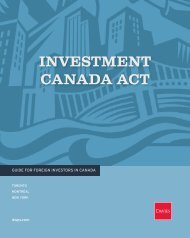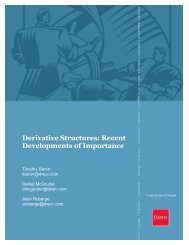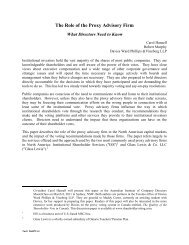doing business in canada - Davies Ward Phillips & Vineberg LLP
doing business in canada - Davies Ward Phillips & Vineberg LLP
doing business in canada - Davies Ward Phillips & Vineberg LLP
- No tags were found...
Create successful ePaper yourself
Turn your PDF publications into a flip-book with our unique Google optimized e-Paper software.
displacement, lay<strong>in</strong>g-off, suspension, dismissal or conditions of employment of a person or <strong>in</strong> the establishmentof categories or classes of employment. The prohibited grounds are race, colour, sex, pregnancy, sexualorientation, civil status, age (except as provided by law), religion, political convictions, language, ethnic ornational orig<strong>in</strong>, social condition, handicap, or the use of devices to palliate a handicap. However, the Charterspecifies that dist<strong>in</strong>ction, exclusion or preference based on the aptitudes or qualifications required foremployment, or justified by the charitable, philanthropic, religious, political or educational nature of a non-profit<strong>in</strong>stitution or an <strong>in</strong>stitution devoted exclusively to the well-be<strong>in</strong>g of an ethnic group is deemed nondiscrim<strong>in</strong>atory.It also provides that every employer must pay equal wages to every employee perform<strong>in</strong>gequivalent work at the same place without discrim<strong>in</strong>ation on prohibited grounds.Québec's Commission des droits de la personne et des droits de la jeunesse <strong>in</strong>vestigates compla<strong>in</strong>ts ofdiscrim<strong>in</strong>ation and acts as a conciliator between the parties. If conciliation fails, the matter may go tonegotiated settlement or before an arbitrator or, if recourse to such remedies is not agreed to by the parties, toa hear<strong>in</strong>g before the Tribunal des droits de la personne. The Tribunal may impose any remedial measures,<strong>in</strong>clud<strong>in</strong>g the re<strong>in</strong>statement of a worker when such outcome would be fair and expedient under thecircumstances.PAY EQUITYIt is illegal <strong>in</strong> every prov<strong>in</strong>ce <strong>in</strong> Canada to pay a woman less for <strong>do<strong>in</strong>g</strong> the same job as a man.Ontario and Québec each have adopted, through a Pay Equity Act, the pr<strong>in</strong>ciple of equal pay for work of equalvalue. Women <strong>in</strong> "female job classes" who perform jobs of similar value to employees <strong>in</strong> "male job classes" havethe right to salary readjustments.In Ontario, the Act applies to all private sector employers who employ ten or more employees and all employers<strong>in</strong> the public sector. However, <strong>in</strong> the private sector certa<strong>in</strong> provisions of the Ontario Act, requir<strong>in</strong>g an employerto devise a pay equity plan, apply only to employers with 100 or more employees. In Québec, the Act applies toprivate and public sector employers with ten employees or more. Employer obligations vary depend<strong>in</strong>g on thenumber of employees and <strong>in</strong>clude devis<strong>in</strong>g a pay equity plan if the employer employs 50 or more employees andsett<strong>in</strong>g up a pay equity committee if it employs 100 or more employees.EMPLOYMENT EQUITYThe Employment Equity Act applies to federal sector employers only. The legislation is an "affirmativeaction/hir<strong>in</strong>g quota" system designed to encourage employers to hire and promote women, aborig<strong>in</strong>al people,the disabled and visible m<strong>in</strong>orities. Certa<strong>in</strong> non-federal sector employers must comply with the EmploymentEquity Act <strong>in</strong> order to obta<strong>in</strong> federal contracts.EMPLOYMENT INSURANCEEmployers and employees <strong>in</strong> Canada are required by the Employment Insurance Act to contribute to theemployment <strong>in</strong>surance account adm<strong>in</strong>istered by the federal government. Employee premiums are calculatedeach year. For 2010, the employee premium is 1.73% (1.36% <strong>in</strong> Québec) of <strong>in</strong>surable earn<strong>in</strong>gs up to a maximumof $43,200 (so that the maximum employee premium <strong>in</strong> 2010 is $747.36 ($587.52 <strong>in</strong> Québec)). The employermust pay a premium equivalent to 1.4 times the employee's premium. The employer's contributions aredeductible for tax purposes as a normal <strong>bus<strong>in</strong>ess</strong> expense and may be reduced if the employer supplies a salary<strong>in</strong>surance scheme to its employees.Unemployment <strong>in</strong>surance benefits are paid to employees who lose their jobs due to layoff or term<strong>in</strong>ation.Employees on maternity leave, parental leave, or absent due to illness are also covered.58 Employment Law
















